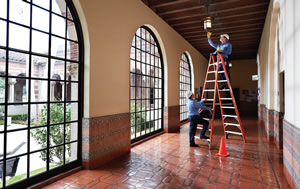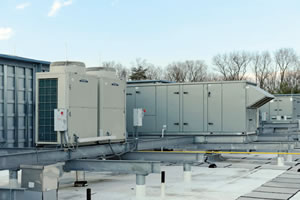Using Energy Benchmarking to Reap Savings

PHOTO COURTESY OF ABM BUILDING SOLUTIONS
Put simply,” according to the Energy Star Website (www.energystar.gov), “benchmarking is the process of comparing your energy performance to something similar. ‘Something similar’ might be internal, like performance at the same time last year. Or it might be external, like performance compared to similar facilities elsewhere.” Energy Star is a U.S. Environmental Protection Agency voluntary program that helps businesses and individuals save money and protect our climate through superior energy efficiency. Many school administrators are using the Energy Star Website and other resources to benchmark and gain energy savings.
If you’re not benchmarking, it’s worth considering. “Most of the administrators we work with still do not have the information available to make informed decisions about their facilities because they haven’t invested the money or seen the importance of benchmarking,” says Joel Lowery, director of Sales for Alpharetta, Ga.-based ABM Building Solutions. “It’s a great way to save energy and make everyday operation decisions, such as if it might be more energy efficient to have four, 10-hour days in the summer, or where is the most energy efficient place to hold summer school.”
Neil Maldeis, P.E., CEM, Energy Solutions Engineering manager Davidson, N.C.-based Trane, a brand of Ingersoll Rand, concurs with Lowery, noting, “The obvious reason to do benchmarking, and this applies to anybody, is that it gives you a snapshot of how your facilities are performing and, specifically, in terms of energy. With that data you can identify facilities and/or areas where you can improve upon energy use, which helps drive costs down.”

PHOTO COURTESY OF MITSUBISHI ELECTRIC US COOLING & HEATING DIVISION
Getting started
Not sure what it takes to get started? How about this? “Depending on the level of benchmarking you want,” says Maldeis, “it actually requires very little to get started. You can do benchmarking around your historical utility information. It’s good to begin with a year’s worth of data. With that, and some basic size knowledge of your buildings, you can come up with a fairly good idea of the energy consumption per square foot for your facilities, which is usually measured as BTUs per square foot.”
Another option for collecting the data is a free tool on the Energy Star Website. “The initial investment,” says Maldeis, “is time — time to input the data. There’s no initial equipment or software investment.”
Most organizations use the information to triage their own facilities. “You get the BTUs for 10 buildings, let’s say,” Maldeis says, “and sort them from high to low, which is also worst to best. Then you start finding places to make improvements in the buildings that have high energy use indexes. It’s simple, and it’s easy to do. After that, you can look at data from peer organizations to make comparisons.”
Cost comes into play when you’re ready to start implementing improvements to drive down the BTUs per square foot. That cost is really an investment because you earn it back through time via energy savings. Maldeis explains: “Benchmarking identifies the potential for savings. For example, take a school operating at around 100,000 BTUs per square foot: you could have a potential of 20,000 to save. Someone has to do an energy audit to try to understand why the facility is above 80,000.” Then improvements are made to the trouble spots. For example, changing the lighting can bring down the BTUs per square foot.
Most organizations opt to make improvements in what is commonly called “low-hanging fruit,” which are measures that have two- to four-year payback times. Once those measures are completed, they look to invest in measures that have five- to 10-year paybacks. “A lot of schools,” says Maldeis, “are using aggregate paybacks. That is, they’re combining measures that have low payback times with ones that have long payback times to accomplish more in a 10-year aggregate payback.”
Colquitt County Schools
Administrators at Colquitt County Schools (CCS) in Moultrie, Ga., educate approximately 9,600 students. The district is benchmarking and seeing the results. “What motivated us to begin benchmarking,” says Dr. Brad Gregory, CCS’s assistant superintendent of Finance, “was energy costs in general, which had been increasing. We receive state funding for maintenance and operations, and the amount is barely enough to cover our energy costs of $2.4 million per year.” The district has a progressive, yet also conservative, team in its school board and superintendent, who look for cost-effective innovations.
After putting benchmarking to work, CCS administrators have taken the next step, entering into a contract with ABM to make comprehensive energy and facility improvements to the 14 schools (including one high school currently being built) and facilities that house the county’s Pathways Educational Program, Gifted Services Program and transportation offices. Improvements include replacing more than 50 percent of the district’s HVAC equipment, upgrading lighting and installing centralized building controls with remote capabilities.
“The program provides a funding source for the upgrades that is budget neutral,” says Gregory. “The easiest selling point to our Board was that we could continue to spend $2.4 million on existing energy costs or install brand new equipment that is paid for via energy savings plus have a little bit of money returned to the general fund.
“Where the rubber meets the road,” Gregory continues, “is that we will be able to show the savings to the community. We raised our millage rate this year by two mils for an additional $1.6 million. We’ve been hit with healthcare costs, and teacher retirement has increased in recent years. In 2009, we spent $5.5 million for healthcare for 1,500 employees, and we’re spending $10 million this year. So these improvements are a real game changer. If we can save energy money, it frees up money for things we can’t control, and it changes how we deal with our tax increases.”
Indeed, the district is guaranteed savings of $19 million in energy and operating costs through the next 15 years, generating more than $100,000 a year in general fund relief.
Stafford County Schools
Administrators at Stafford County Schools (SCS) in Virginia, who educate approximately 27,000 students, are also benchmarking. “We are tracking our energy consumption with the idea to reduce it through time through a variety of different tools,” says Scott Horan, assistant superintendent for Operations. “We know where we started about 10 years ago from an energy consumption point of view in all our schools.”
The district has entered into two energy performance contracts that address energy control measures, such as installing occupancy sensors, changing lights, reducing water usage and installing variable frequency drives. Also, in the last 10 years, as roofs have been replaced, they’ve been replaced with reflective roof coatings to reduce heat load. “That’s one reason we’ve seen energy consumption cost per square foot come down,” Horan confirms.
Another tool the district has recently used is installing Variable Refrigerant Flow (VRF) zoning (HVAC systems) when renovating their concrete/cinder block schools. The VRF technology has proven ideal in buildings unable to accommodate ductwork because of tongue and groove, pre-stressed precast concrete construction.
“With the VRF zoning system, we were able to keep the original ceiling and planned suspended ceiling heights, improve lighting levels, reduce sound levels in classrooms to NC 30 (Noise Criterion) or quieter, and improve student comfort,” says Bruce E. Beddow, PE, CEM, president of b2E Consulting Engineers in Leesburg, Va.
One school specifically, Falmouth Elementary, is saving $70,000 on energy costs with the VRF technology. For a utility bill comparison, Horan estimates a 25- 30-percent average reduction in energy use. “This is impressive when you think that we increased the building area by about 20 percent or 13,000 square feet,” he observes.
In addition, administrators are retro commissioning older schools, tackling one per year in the last six years. “This involves looking at the original design and seeing if the equipment is performing as designed,” says Horan, “as well as what we’ve done to it through the years to throw it out of performance and correcting it.”
The results are there. “We have gone from spending $2.04 per square foot for energy in 2005 to $1.31 in 2014,” says Horan, “and that includes adding six new schools in that time.”
Are you ready to benchmarking? Start with the Energy Star Website. Beddow recommends using a certified energy manager to calculate an energy utilization index so yearly comparisons can be made. With that knowledge, “You’ll get an idea of how your buildings are performing and be in a position to make upgrades in a way that will make a big difference,” he says.
This article originally appeared in the issue of .